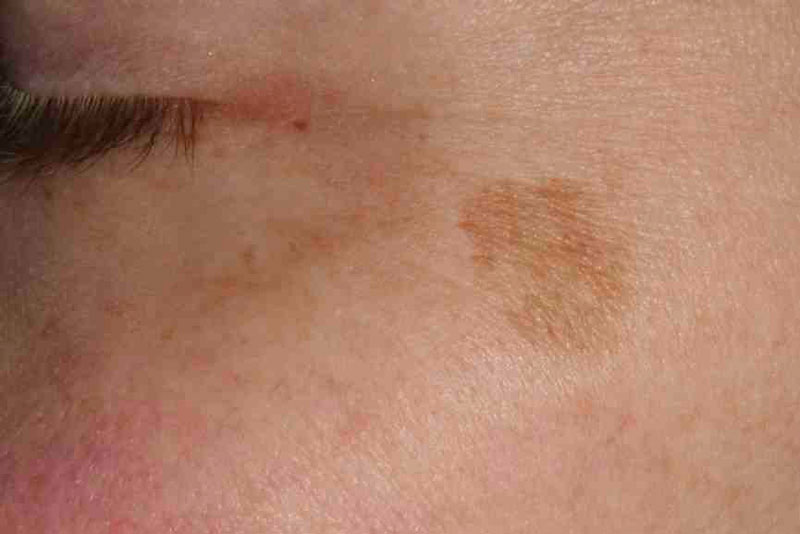SOLAR LENTIGO

Definition: A solar lentigo is the medical term for freckle. A freckle is caused when the melanin-producing cell, or melanocyte, is damaged by UV radiation causing it to get bigger [1] and to be visible to the naked eye.
Other names: Age Spots
Signs and Symptoms
Solar lentigines typically appear on areas exposed to natural or artificial UV light and are well-defined, hyperpigmented light brown to black flat spots [2]. Solar lentigines may be single or multiple in number.
Solar lentigines are usually benign, but they do indicate excessive sun exposure, a risk factor for the development of skin cancer.[2]
Preventative Care
To prevent solar lentigines avoiding exposure to sunlight and wearing sunscreen is paramount. Apply sunscreen (SPF 30 UVA and UVB block) DAILY. Additionally, when outside sun-protective clothing (tightly woven clothes) and hats can reduce sun exposure and prevent solar lentigines.
See your doctor about any moles or spots on your body that you are concerned about.
Treatment
Over-The-Counter
Fade creams and lotions are available in department stores, in drugstores and on the Internet to lighten age spots and other skin discoloration. These may be good options depending on the darkness of the age spot and how often you apply the cream. Successful treatment needs to penetrate through the base of the epidermis — the topmost layer of skin — where the extra pigment is located. This means regular use over several weeks or months may be necessary before any noticeable results occur. [3]
Bleaching creams are good for bleaching large areas of discoloration such as melasma. But when you’re trying to treat individual age spots, bleaching creams tend to bleach the area around the spots more than the spots themselves. Thus the topical bleaching creams are usually not good for bleaching individual brown spots because it is impossible to confine the cream to the area where the spot is, which usually results in a ring around a brown spot. [5]
When choosing a nonprescription fade cream, choose one that contains hydroquinone, deoxyarbutin, glycolic acid or kojic acid. [3] These are the best skin lighteners. Note that some products, especially those that contain hydroquinone, may cause skin irritation after prolonged use. [3]
Topical Retin-A, on the other hand, can be good but it can also be irritating, especially to patients with light skin. In addition, you should never use bleaching creams or products like Retin-A or alpha hydroxy acids (which can also lighten the skin), without first using a sunscreen in the morning because all bleaching creams, Retin-As, and alpha hydroxy acids make you more sensitive to the sun. [5]
Laser Removal
Laser treatment (usually with a Fraxel laser) is generally very effective at removing age, liver, sun or brown spots on the skin. It is often the treatment of choice for these spots [4]. However, treatment may require two or more sessions to completely remove the spots depending on how many there are and on which area of the body. Removal of age spots is permanent however people do sometimes see new spots appear as they go back out into the sun. These are new spots forming as a result of sun exposure, not a recurrence of the old, removed spots. Pain is Minimal during treatment and treatment time depends on body area. [4]
Chemical Peel
Chemical peels involve the application of a chemical solution to the surface of the skin and there are many different types of chemicals and methods of application. The solution dissolves the damaged, age-spotted surface tissue. The damaged skin is then replaced with a more youthful looking layer. There is usually little downtime from a chemical peel, though you may experience some redness or irritation immediately following the treatment. [4].
Microdermabrasion
Microdermabrasion rejuvenates the very upper layers of the skin (the stratum corneum) where it exfoliates the skin and removes dead cells. This results in an improvement in the texture of the skin, diminishing fine lines and improving areas of darker pigmentation such as age spots. A doctor may be more or less aggressive with microdermabrasion and do it in combination with other techniques. [4]
Cryosurgery/Cryotherapy
Cryotherapy destroys and removes abnormal skin cells through freezing with liquid nitrogen. It can be applied directly to the skin with a swab or sprayed on. It more rarely is used for age spots. Generally cryosurgery for age spot removal is a quick procedure, with no downtime. The potential side effects may be some blister formation, bleeding, hypopigmentation and in rarer causes, scarring. [4]


